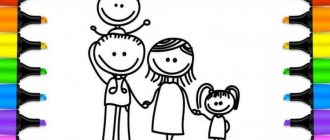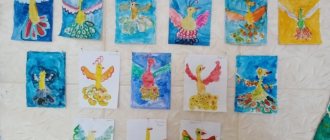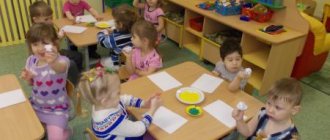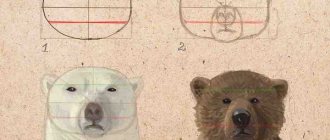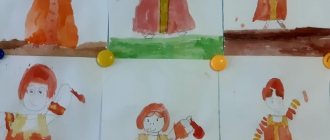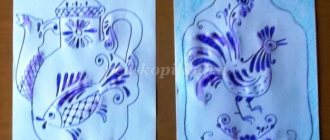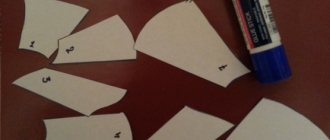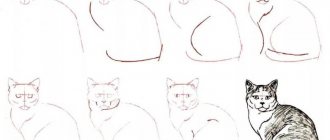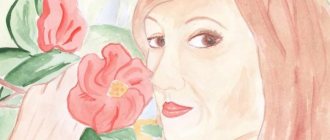Techniques and techniques that will be used in a drawing lesson in the senior group
The fairy tale captivates the child with a mysterious plot, immerses him in the world of thoughts and feelings of the heroes, their fates are remembered for a long time, every time the children seem to overcome obstacles anew, experience adventures together with their favorite fairy-tale characters. Almost all topics related to the illustration of fairy tales cannot be done without depicting a human or animal figure, which is part of the plot composition of the drawing. Depicting a living character is not easy for children, since older preschoolers are given more complex tasks, which involve moving away from simplified schematism and reinforce in children the desire to convey their thoughts, observations, and life experiences in the drawing.
Drawing tasks on fairy tale themes:
- continue to introduce students to Russian folk and literary fairy tales;
- teach children to embody their ideas in drawings, convey images of heroes and impressions of a fairy tale they heard;
- develop the ability to draw human and animal figures according to a diagram, learn to convey simple movements (turning and tilting the head, raised and bent arms, step) without violating the proportions;
- develop the skills of independently selecting material for an image, as well as an episode from a fairy tale plot, constructing a composition across an entire sheet of paper, correctly placing characters and objects in space;
- learn to create a pencil sketch that precedes the stage of coloring with pencils or paints;
- teach to convey the characteristic features of characters, their mood;
- improve the ability to draw with pencils, felt-tip pens, watercolors and gouache paints, mix colors to obtain the desired shade.
Children learn to embody an artistic concept in a drawing and convey their impressions of a winter fairy tale.
Types of drawing:
- Subject - a single image of a fairy-tale character or object, for example, Thumbelina, Kolobok, Winnie the Pooh, a hut on chicken legs, a magic castle, etc.
- Plot composition is a visual form of a story about any events or actions, built on the interaction of several characters and objects (“Masha and the Bear”, “Fox and the Hare”, “Geese-Swans”, etc.).
Classic techniques:
- Drawing with a simple pencil.
- Drawing with colored pencils.
- Drawing with wax crayons.
- Drawing with felt-tip pens.
- Drawing with charcoal and sanguine.
- Combined method (colored pencils and watercolors, felt-tip pens or wax crayons).
- Painting with a brush using gouache - the distinctive property of this material is its opacity, which allows you to overlap layers with a new color.
- Painting with a brush using watercolors. Children need to be taught the skills of regulating paint set, selecting colors, and softly conveying shades by mixing primary colors.
Children's works in classical techniques (photo gallery)

"The Ugly Duckling" (watercolor)
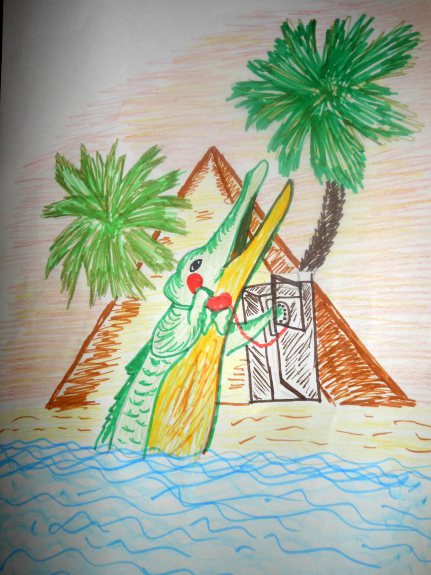
“My phone rang” (crayons and colored pencils)
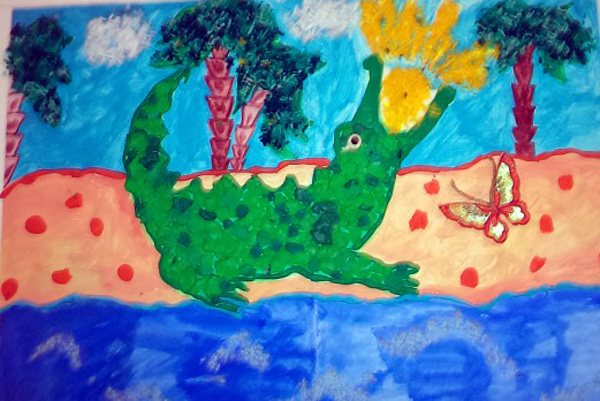
Drawing “Stolen Sun” (gouache and felt-tip pens)
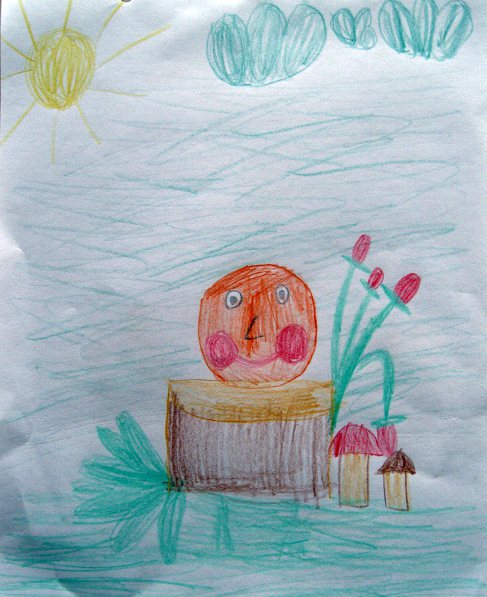
Drawing “I left my grandmother...” (colored pencils)
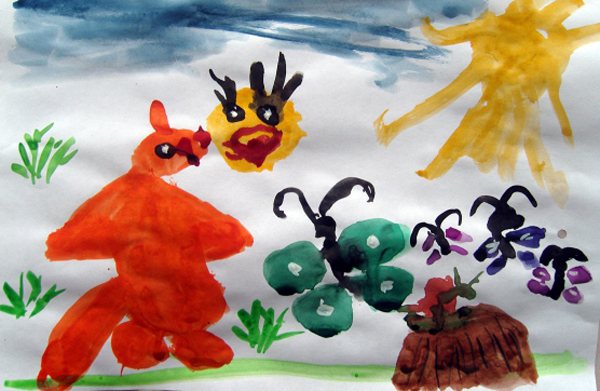
“The Fox and the Gingerbread Man” (watercolor)

“Thumbelina” (gouache and felt-tip pens)

“The Snow Queen” (wax crayons and markers)
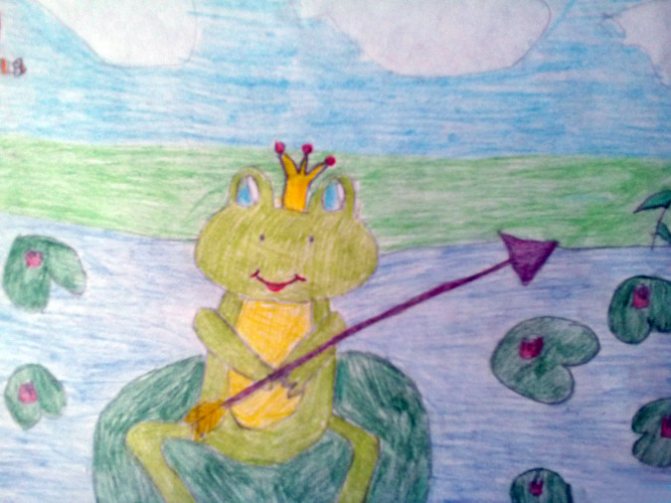
Drawing “The Little Princess” (colored pencils and markers)

“Winter's Tale” (markers and colored pencils)

“Winter's Tale” (watercolors and markers)
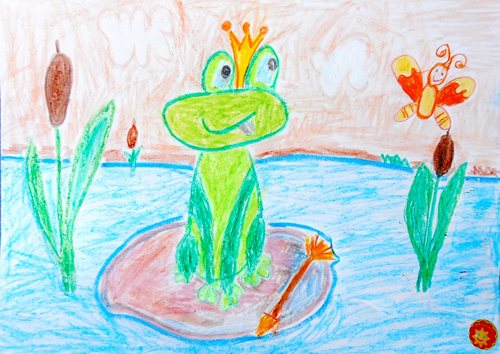
Drawing for the fairy tale “The Little Princess” (wax crayons and felt-tip pens)
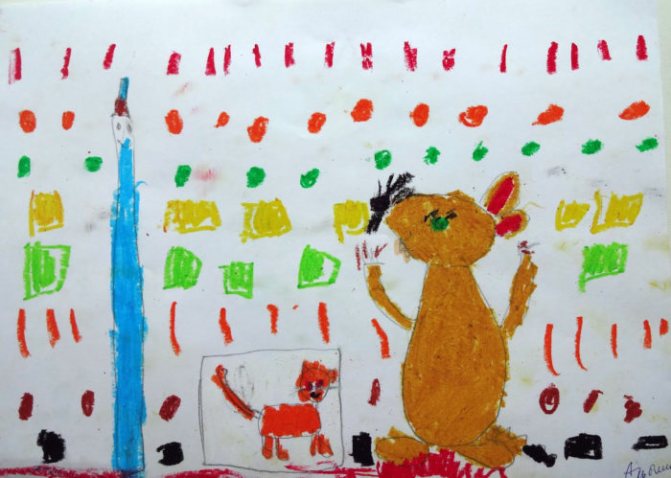
Drawing for the fairy tale “The Mouse and the Pencil” (wax crayons and felt-tip pens)

"The Ugly Duckling" (colored pencils)

“Geese-swans” (watercolor and gouache)

“Geese-swans” (watercolor)
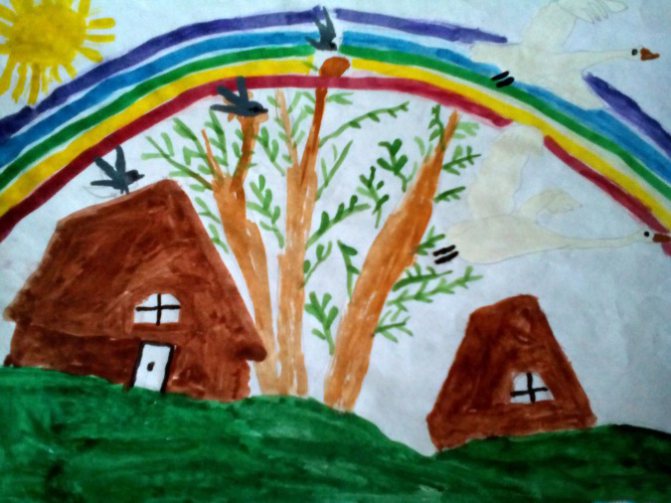
“Geese-swans” (watercolor and felt-tip pens)
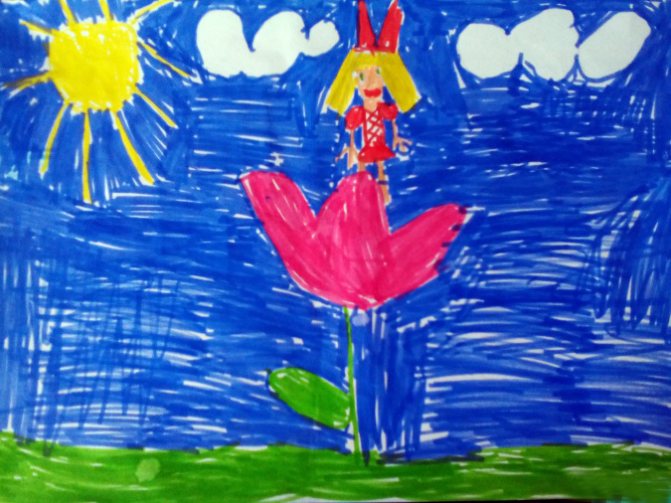
“Thumbelina” (felt pens)
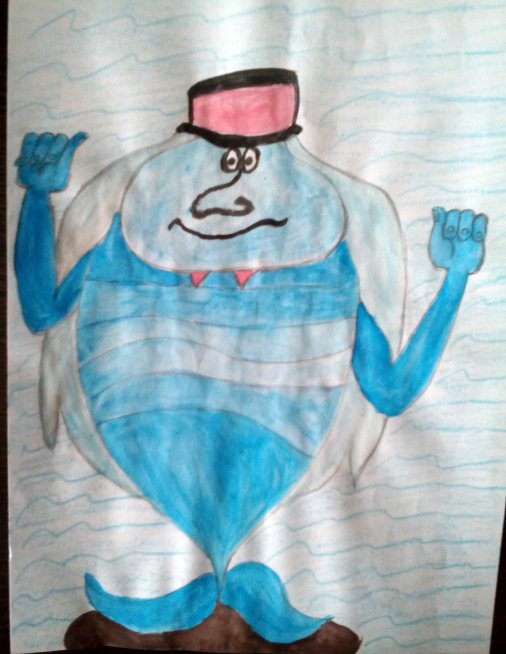
Drawing “Water” (watercolor)

Drawing “Masha and the Bear” (colored pencils)

Drawing “Under the mushroom” (felt pens)

Drawing “Apple” (colored pencils)
Non-traditional techniques:
- Finger drawing - older preschoolers independently decide on the choice of theme for drawing, using finger techniques in combination with traditional techniques.
- Palm painting - based on children's handprints. Six-year-old children apply paint to their palm with a brush on their own, then complete the contours of the figure and draw in the details.
- Drawing on wet paper is a blurry, hazy image that is applied to a pre-moistened sheet of paper.
- Drawing using rock salt, semolina, colored sand. With the help of colored sand, interesting crafts are created by filling the silhouette, previously smeared with glue.
- Bleeding drawing - an image is drawn with wax crayons or a wax candle on white paper, then painted over with a top layer of watercolor in one or more color shades.
- Drawing with crumpled paper - drawing an image using a paper ball crumpled from a piece of paper.
- Pointillism (dot painting) - drawing with dots, dotted strokes using fingers, cotton swabs, cotton swabs, pencils with an eraser at the end or a brush.
- Stamping is an image of objects or natural phenomena by applying an imprint on paper using a stamp and stencil (foam rubber swab, wooden stamps, from vegetables, fruits, waste material, etc.).
- Vertical poke with gouache using a hard semi-dry brush without using water to obtain a visual texture effect (fluffiness, volume, relief).
- Scratching is scratching the outlines of a design onto a surface primed with wax or paint.
Children's works using non-traditional techniques (photo gallery)
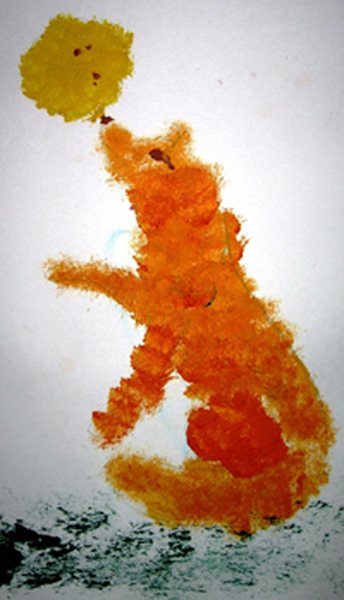
“The Fox and the Gingerbread Man” (poke)
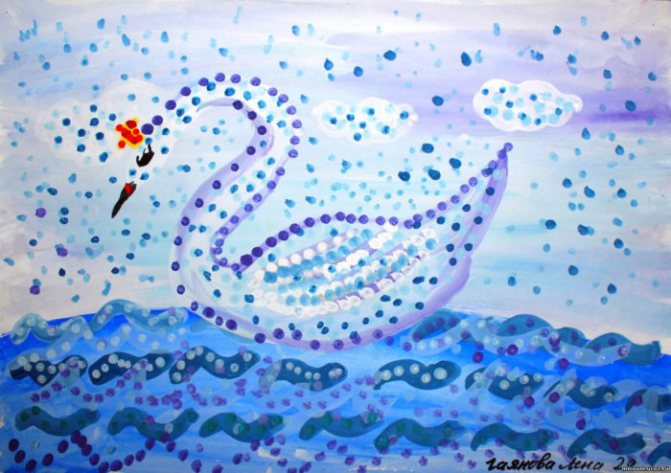
Drawing “Swan Princess” (pointillism)
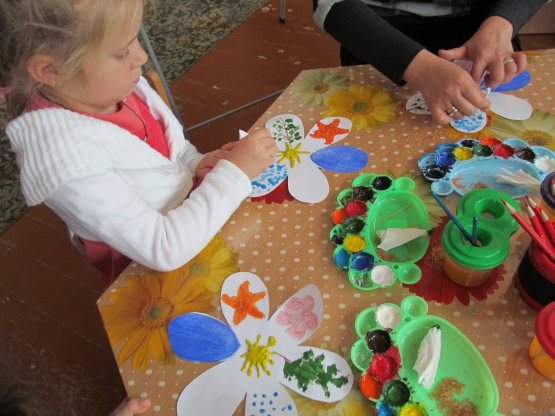
Design of a blue petal (drawing with cotton swabs), green (poke)

Design of the sun (plastinography), blue petal (drawing) and violet (coming through pattern, drawing with a candle)

Drawing “Swan Princess” (pointillism)

Drawing “Swan Princess” (drawing with salt)

“Firebird” (leaf print and palm painting)

Drawing “Senor Rain” (drawing on wet)
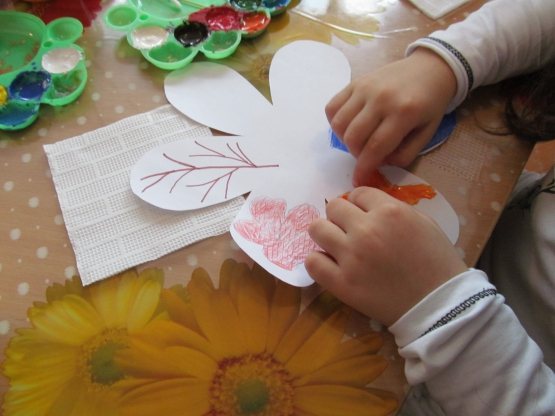
Design of a red petal using a textured pattern technique (place a mesh and shade with a red pencil), an orange starfish (drawing with salt)

Drawing “Winnie the Pooh and his friends” (drawing with colored sand)
The order of drawings
Children draw on the theme “My Favorite Fairy Tale” with pencils and paints. In a lesson in the senior group, it is recommended to practice the ability to make a sketch - classical drawing techniques are based on it.
Step-by-step drawing based on the fairy tale by V. G. Suteev “The Bag of Apples”
- Drawing a pencil sketch: the head and body of a hare in the form of geometric shapes.
Drawing a sketch develops thinking: the child sees shapes inside the object - Hatching inside the contours.
Remind children that the hatch lines should be in the same direction. - Feathering.
This is an optional step, but children should become familiar with this drawing technique. To make the work neat, when shading, you should not go beyond the boundaries of the image with your finger. - Drawing contours and small details.
The same simple pencil is used, but you need to draw with increased pressure. The ability to determine the required degree of pressure on a pencil comes with time, training is important - Drawing details: ears, face.
The bunny is a positive character in a fairy tale, that’s why he has a kind face - Drawing a character attribute.
This can be a challenging task for gifted children. In the finished drawing the bunny is depicted with a bag of apples for his family
Step-by-step drawing based on the fairy tale by D. N. Mamin-Sibiryak “The Gray Neck”
- A pencil sketch can be made for a figure in motion.
For example, Gray Neck flapped her wings. To sketch a figure in motion, there must be a figurine in a similar position in front of the child’s eyes, or he himself tries to take this position. - Coloring with colored pencils.
The direction of the hatching changes on different parts of the object. You need to paint with colored pencils very carefully: do not erase the excess beyond the outline with an eraser - Stroke with a simple or black pencil, addition of small details (feathers, eyes).
Let children trace the drawing with a pencil to practice applying pressure. - Background objects are drawn with colored pencils.
For example, a pond, reeds, shore. Colored pencils are an excellent material for creating fabulous illustrations
Step-by-step drawing based on the fairy tale “Kolobok”
- Tinting paper with watercolors - one color.
It is fashionable to tint paper with both a brush and a sponge - offer your child a choice of tools - The designation of earth and sky on a sheet is to draw wide stripes or print using the monotype technique on wet watercolor.
Details are painted with a thin brush
Step-by-step drawing based on the fairy tale “Turnip”
- Designation of the horizon line on paper.
Background fill - sky and earth. The teacher shows, using landscape photographs as an example, that a composition is successfully built where a strip of land is narrower than the heavenly space. The guys have to think about whether Repka is the main character in the fairy tale. - Drawing an animal character from a fairy tale: a dog, cat or mouse.
You can personalize the task: by choosing a character and the ability to draw his attribute. For example, for the bug - a booth, for the cat - a bowl of milk, for the mouse - a spikelet.
Thus, the turnip is an obligatory object for a fairy-tale composition, but it can be placed in the background
Photo gallery: examples of finished works
Pencil drawings are not easy for children, but they look amazing Drawing based on the fairy tale “The Three Bears” develops a sense of proportion in children: bears are of different sizes Drawing an illustration for a fairy tale is a complicated task Work for an exhibition or competition: there is a background, background and details Children of the sixth year of life are fond of detailing the background. Drawing human characters or “humanized” animals can be organized using stencils
Video: “Drawing Kolobok from a fairy tale with Pavlik”
This video is a clear demonstration of how a child learns to reproduce a pattern. An adult shows geometric shapes and ideal elements. The child’s results are similar, but not nearly as smooth and neat. Remember, children need to be praised for their efforts. Their drawings will never be the same as diagrams and samples. But they will definitely be unique and inimitable.
Photo gallery: drawings in unconventional techniques
For the drawing based on the fairy tale “Kolobok”, the technique of finger painting and applique with semolina was used. The drawing “Geese-swans” was drawn with palms and fingers. “The hut on chicken legs” was drawn using the pointillism technique: with dots. Poking with a hard brush is one of the simple non-traditional techniques
72 drawings took part in the competition. Each drawing was accompanied by a story about the family and a general family photo. These are interesting, bright, amazing stories.
The editors of “Pravmir” and the curators of the “Library of Loving Parents and Happy Children” project decided to additionally award eight participants of the competition a book of fairy tales “The Happy Prince” with an autograph and wishes from the author of the collection, Archpriest Alexander Ilyashenko. There will be additional material about this on Pravmir.
Drawing techniques on the theme “My favorite fairy tale” for older preschoolers
Older preschoolers are actively improving their drawing techniques with pencils, crayons and felt-tip pens, since shading helps strengthen the muscles of the hand, develop fine motor skills and coordination of movements, and therefore helps prepare children for school stress.
- The line is the main method for sketching, which is taught to six-year-old children. A line can be of different lengths and rhythms and helps to depict a contour, conveying the nature of the object’s shape, its size, dynamics and proportions.
- Hatching is a fairly simple, but expressive and effective way of conveying the character of a character (lightness, heaviness, flexibility, plasticity, etc.) and the texture of an object. Drawing with strokes helps not only to reveal the image of an object, but also to develop fine motor skills, which is very important for solving the problem of preparing for writing. Types of shading:
- Chaotic - the strokes are laid in a free direction, then they are formed by additional contour drawing of the outlines of the object.
- Vertical - dense strokes are applied in a vertical direction. Using colored pencils with different pressure levels will allow you to get the effect of a smooth change of various shades.
- Diagonal - most popular in the landscape genre for depicting, for example, rain or silhouettes of mountains.
- Horizontal is a rather difficult technique to perform, since it requires the child to change the usual position of the hand during the drawing process.
- Shape-building is a technically complex and time-consuming way of conveying the shape of an object, for example, a cloud or the crown of a tree.
- Shading helps to achieve different degrees of color saturation depending on the degree of pressure of the pencil. Drawing an outline requires more pressure than painting the silhouette of an object or creating a background pattern.
- Dot, rhythmic stroke, brush stroke using the technique of painting with watercolors and gouache paints.
Notes on drawing "My Favorite Fairy Tale" for children of senior preschool age
Ekaterina Logacheva
Notes on drawing “My Favorite Fairy Tale” for senior preschool children
Municipal budgetary preschool educational institution No. 6 “TsRR-kindergarten”
Kingiseppa
Drawing in the senior group on the topic “My favorite fairy tale ”
favorite fairy tales in drawings .
fairy tale characters in drawings .
Develop the skills to place an image throughout the sheet.
Develop creative imagination when creating illustrations for your fairy tales .
Activate children's .
Develop skills in holding a pencil correctly.
To cultivate an aesthetic attitude towards works of folk art.
Organization and conduct of classes
The rich theme of “My Favorite Fairy Tale” is revealed in the process of versatile pedagogical work aimed at cognitive, speech, social-communicative, artistic and aesthetic development. Drawing classes can be conducted both in a narrowly focused format and within the framework of short-term and long-term projects on this topic (“Russian folk tales”, “Fairy tales of A. S. Pushkin”, “Tales of the peoples of the world”, “Fairy tales of H. H. Andersen” ", "Tales of Chukovsky", "Tales of V. Suteev", etc.).
Large plot compositions, which consist of several characters and objects, are usually created collectively. The preparatory stage, during which the background is tinted, individual figures are drawn, details are worked out, is carried out in small subgroups of 3-4 people, and then the children together compose a plot picture on whatman paper, gluing the silhouettes they have prepared, simultaneously developing spatial thinking abilities, gaining experience in coordinated actions. In the process of collective creativity, children rely on a condition set by the teacher or a free plan, improving the social skills of mutual understanding and camaraderie.

A Christmas Tale - working with elements of appliqué and plastinography
It is important to develop in children an understanding of the correct sequence of stages of work to create a collective plot composition or collage:
- make a background image divided by a horizon line;
- draw background objects (trees, sun, clouds, flowers, etc.);
- draw or place previously prepared and cut out silhouettes of fairy-tale characters.
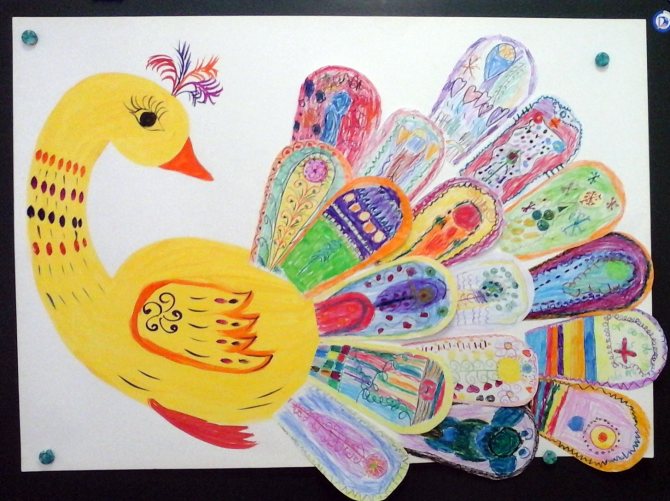
Drawing of the Firebird - each child paints his own feather, then everyone collects the fluffy tail of a fairy-tale bird together
Lesson outline
The senior group has one drawing lesson per week. The total duration of continuous activity should not exceed 20–25 minutes; methodological manuals recommend performing physical exercises (finger, breathing, motor exercises) for 5 minutes to neutralize psychological and mental stress, as well as prevent physical fatigue in children.
- Organizational part (3–5 minutes). The practical part of the lesson can be preceded not only by reading a fairy tale or literary work, but also by viewing pictures, a slide show, a fragment of a film or cartoon. The informational and familiarization stage involves awakening children's interest in the fairy tale plot, studying the characters of the main characters and the sequence of events. It is necessary to include surprise moments, elements of theatrical play, stimulating curiosity, causing a positive emotional reaction and activity.
- Practical part - the teacher explains the sequence of creating a composition and drawing the main characters based on the diagram (3-5 minutes). Older preschoolers are given more freedom in the drawing process; showing a picture or sample prepared by the teacher should not be used for copying, but only to form a correct understanding of the task or clarify it. The work is done from life (toy) or based on the free design of children; the basic techniques have already been mastered, so they do not require additional demonstration.
- Independent work of children (15–20 minutes).
- The final part is the analysis and assessment by children of their works and the drawings of their comrades. Children are taught to formulate their point of view with reason and verbally express the aesthetic perception of creative works (3-5 minutes).
Schemes for drawing fairy-tale characters (photo gallery)
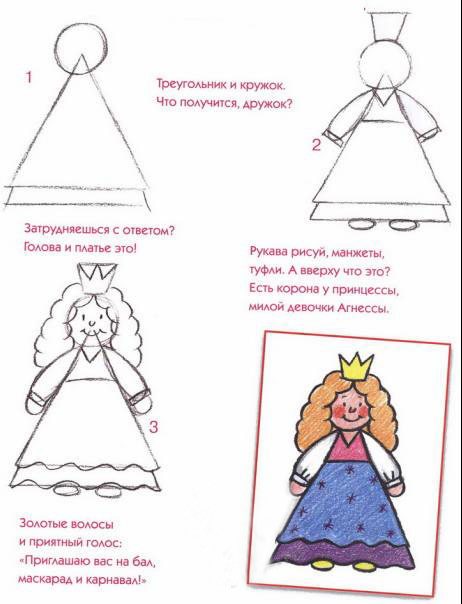
Princess

Clown
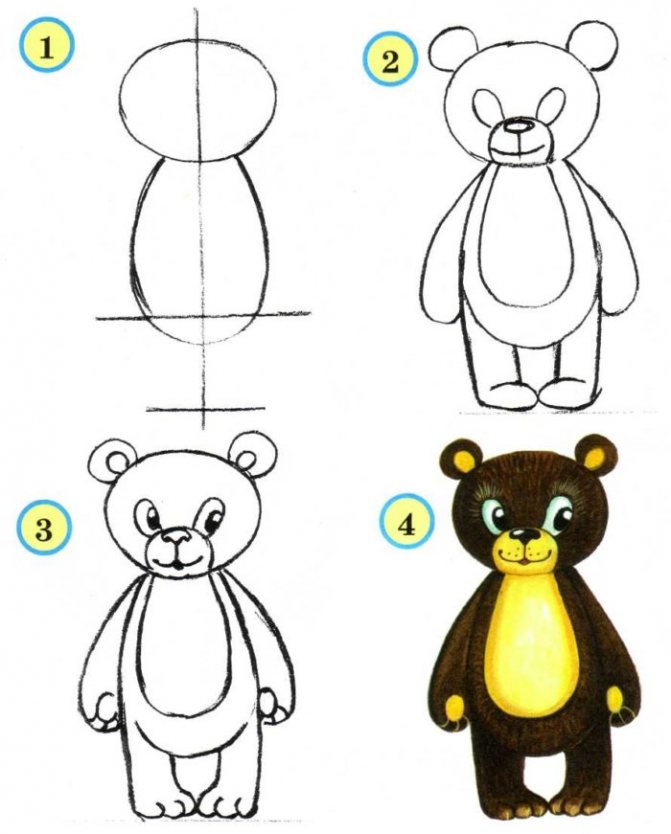
bear

Witch
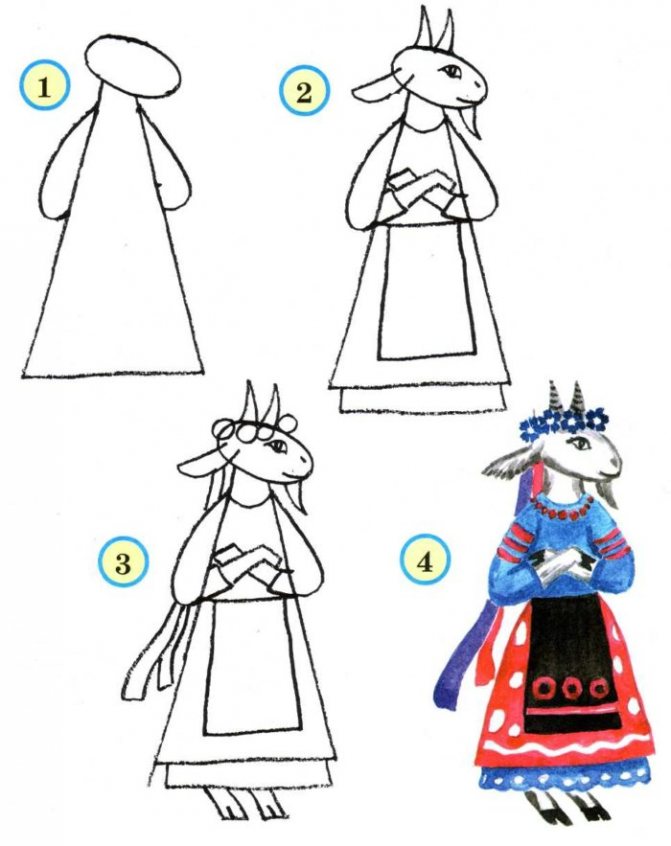
Goat
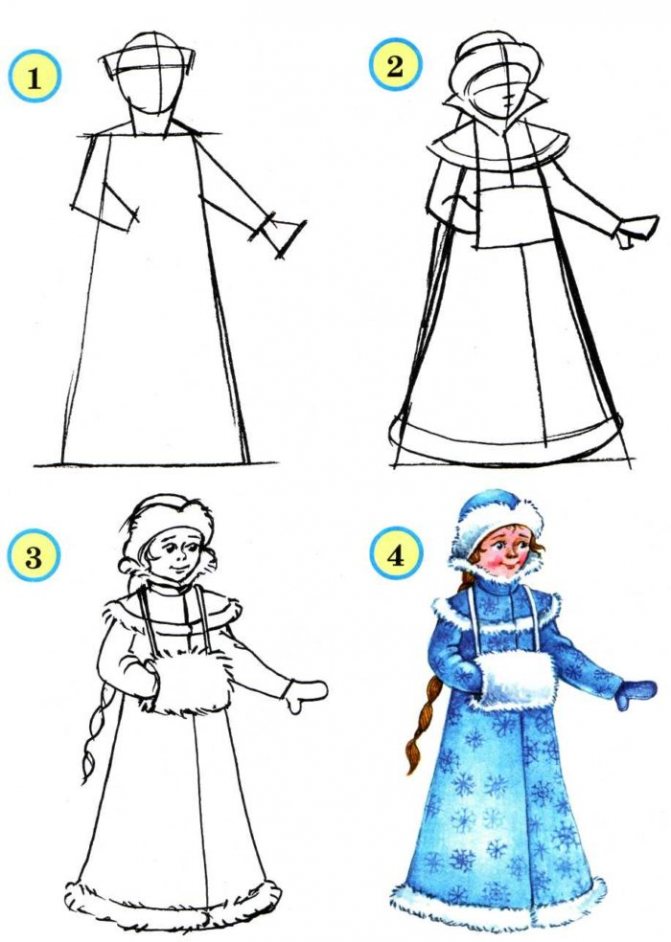
Snow Maiden

The sequence of creating an illustration for the fairy tale about Kolobok
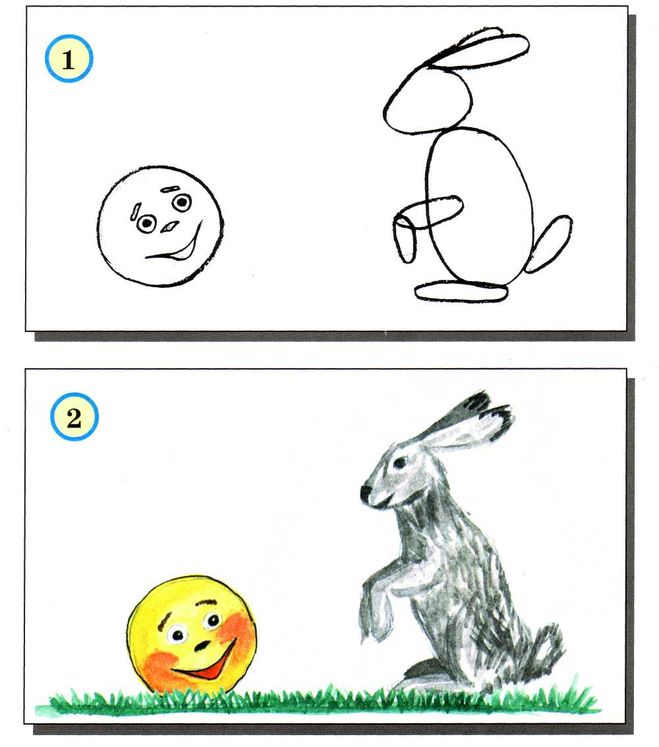
The Hare and the Bun Izbushka

Kolobok Piglet Winnie the Pooh
Lesson summary on the topic “Journey to a Fairy Tale” (author T. A. Sosik)
Goals: Continue to introduce children to oral folk art, consolidate children's knowledge of Russian folk tales. Tasks:
Materials: white paper, gouache, watercolor, brushes, wax crayons, illustrations for Russian folk tales. Didactic games: “Find out by profile”, “Match heroes from fairy tales”. 1. Organizational stage. Educator: At the beginning of the lesson, I want to read you a poem by V.A. Steklovoy There are many different fairy tales in the world, Sad and funny, But we cannot live in the world without them. In a fairy tale, anything can happen, Our fairy tales are ahead, A fairy tale will knock on the door - The guest will say: “Come in.” Today we will go on an unusual journey, to the land of fairy tales. A long time ago, people did not yet know how to read or write, but they were already telling fairy tales. And how they loved to listen to them, and not only small children, but also adults. They will gather in the evening for gatherings: logs are crackling in the stove, the hut is crowded, everyone is busy, some are spinning yarn, some are knitting, some are embroidering, and some are just listening to a fairy tale. The fairy tale has survived to this day, because it was told from generation to generation, passed on from mouth to mouth. Your grandmothers told the story to your mothers and fathers, your mothers told you, and you tell it to your children. This is how a fairy tale came to us from ancient times. What fairy tales do you know? Answers: “Kolobok”, “Teremok”, “Three Bears”, “Geese-Swans”, etc. What kind of fairy tales are these? (Russian folk) Why are they called that? Answers: (Created and written by the people). Didactic games “Find out by profile” and “Match heroes to fairy tales” are held. - Well done! - Guys, do you have any favorite fairy tales? Answers. These are the heroes of these fairy tales that we will draw with you. Selected fairy tale characters (illustrations) are placed on a flannelgraph. 2. Practical part. Look carefully at the heroes of fairy tales and you will see how different they are. The art of portraiture is very ancient. When painting a portrait, artists try to convey the character and inner world of the hero. Fairy-tale heroes can be cunning and gullible, good and evil. But we are all artists in our own way. Let's draw illustrations for our favorite fairy tales. We must try to convey in the portrait the character of the hero, his characteristic features, and moods. Don't forget about your hairstyle, jewelry, and hats. All the little things are important. They also talk about the character of the hero. You have to work very carefully and carefully. What do you think is the ending of the fairy tale? Answers (Always happy, good conquers evil). Right! Well, now let's get to work. 3. Independent work. Children draw. 4. Summing up. After the lesson, the teacher hangs all the drawings in a visible place - the children look at them and tell what fairy-tale character they drew, discuss the characters’ characters, what they are like. |
Artistic creativity. Drawing “My Favorite Fairy Tale” in the senior group
Kalyakina Irina Nikolaevna
Artistic creativity. Drawing “My Favorite Fairy Tale” in the senior group
Program content:
Learn to convey episodes from your favorite fairy tale in a drawing (draw several fairy tale characters in a certain setting)
To consolidate knowledge about the proportions and structure of animals.
Activate children's vocabulary
Develop creativity, attention, imagination, speech
Monitor children’s posture and maintain a physical activity regime.
Learn to evaluate the work of your comrades.
Preliminary work: Reading and looking at illustrations of Russian folk tales, learning poems about animals.
Progress of the lesson.
Guys, a fabulous guest wanted to come to us today. Who will you know if you guess my riddle?
What a strange man
On land and under water,
Looking for a golden key
He sticks his long nose everywhere
Who is this? (Pinocchio.)
He is very upset and sad, they gave him a book, but it doesn’t have beautiful pictures or illustrations and it’s not interesting to read these fairy tales.
— Who are they talking about in your fairy tales? - about animals.
What animals? And you guess the riddle.
She doesn't need a pie
She would like to eat the cockerel. (Fox)
- red-haired, cunning, cheat, deceiver.
1 rocker. Guys, how do we draw a fox? (Show graphical diagram.)
Alyosha, tell me how you will draw (an imaginary pencil in your hand, speaks and draws in the air). The guys repeat the hand movements. Well done. Answers 2-3 children.
Small oval (elongated muzzle) – head
Large oval - Torso
Fluffy big tail - just a drop.
Who else can be drawn according to this scheme? That's right, a wolf's tail will be thinner and shorter than a fox's. Legs are longer.
Showing a diagram of a wolf, discussion. Children's answers.
Nastya, tell us how we draw a wolf.
How did you guess? – long ears, short small tail
Tanya, draw a hare. He speaks and draws in the air.
The general structure of animals: the head is a small oval, the body is a large oval.
Features: The fox has a large fluffy tail - a droplet. The hare has long ears.
What fairy tales do these animals live in?
Kolobok, Teremok, Zayushkina's hut, Chanterelle with a rolling pin, Chanterelle and the gray wolf.
Here is a diagram of the bear. How are we going to draw it (children's answers)
What kind of bear? Big, clubfooted.
Pinocchio, are these fairy tales in your book? Yes.
Girl sitting in a basket
He himself, without knowing it,
What was the girl's name? (Masha)
What fairy tale is this girl from? Masha and the Bear. In what other fairy tales do we see a girl?
Masha and the Bear, Three Bears, Girl Snow Maiden, Fox with a rolling pin.
Karina, remind us how to draw a girl. Display on an easel with colored felt-tip pens.
Buratino, yes, I see you know a lot of fairy tales, you will help me make my book bright and beautiful with color pictures.
He spread his arms to the sides,
Apparently I couldn't find the key.
To get us the key,
You need to stand on your toes.
We sat down at the tables. Landing
For Pinocchio we will draw illustrations for fairy tales. Everyone draws their favorite fairy tale.
Warm up for fingers.
Independent creative activity of children.
Analysis and discussion of works. The guys tell what fairy tale he drew.
Pinocchio takes the work, thanks the guys and leaves.
Scenario for the holiday for Mother's Day in the senior group “My beloved! My dear!" Competitive and game program for Mother's Day in the senior group “My beloved! My dear!" Scenario for Mother's Day in the senior group.
Scenario for Mother's Day in the senior group “My beloved! My dear!" Chanting music sounds, children enter the hall in pairs and sit down in pairs. Presenter: Good afternoon, we tell you! It is no coincidence that we have gathered today.
Wall newspaper “My Favorite Fairy Tale” The motto of the wall newspaper “My Favorite Fairy Tale” can be formulated as follows: “By learning fairy tales, we get to know each other.” The children of the older group were asked. "My favorite fairy tale." Competition of joint creative works of parents and children. My favorite fairy tale.” Competition of joint creative works of parents and children. Why do we need fairy tales? What does a person look for in them? May be,. Photo report “Crafts for the Autumn holiday on the theme “My favorite fairy tale” Photo report Crafts for the Autumn holiday on the theme: “My favorite fairy tale” Conducted by teacher: Irina Ivanovna Bortnikova Photo report Crafts for the holiday. Abstract of the educational activity “My favorite toy” in the senior group of the MDOU kindergarten “Golden grains”. With. Detchino. Educator: Fomina T.V. Goals: to teach children to describe an object from memory according to a given model. Summary of GCD in the preparatory school group. Artistic creativity. Drawing. “Workshop in the village of Dymkovo” Summary of educational activities in a speech therapy group preparatory to school. Artistic and aesthetic development. Drawing. on the topic “Workshop in.
Summary of work with children in the educational field “Artistic Creativity” in the senior group on the topic “Postcard for Dad” Program content: 1. Improve children’s ability to create an object image based on a model. Improve children's ability to act.
Project “My Favorite Fairy Tale” (middle group) Project “My Favorite Fairy Tale” (middle group) Project plan. 1. Relevance 2. Purpose and objectives. 3. Expected results. 4. Characteristics.
Source
